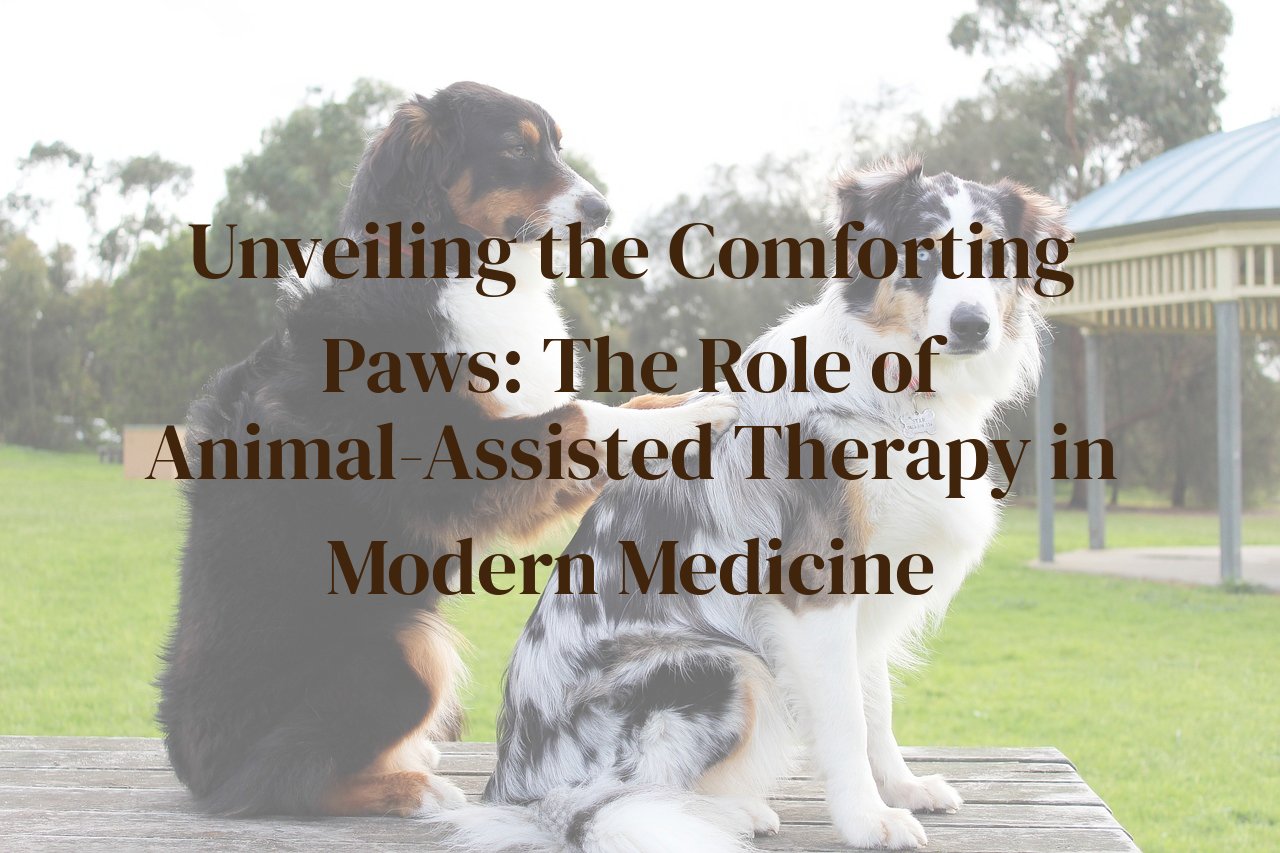
The fusion of animals’ calming presence within the clinical environment is an intersection not commonly explored. However, as we delve into the multifaceted world of healthcare, the incorporation of pet therapy reveals itself as a subtle yet potent method of enhancing patient care. This blog post intends to shed light on how animal-assisted therapy acts as a balm in the bustling realm of healthcare settings, exploring the emotional and physiological gains that accompany it.
Readers embarking on this textual journey will unravel the elegance of non-verbal communication between humans and animals. The information herein will serve as an eye-opener to the scientifically-backed blessings that furry friends impart to patients and healthcare professionals alike—a must-read for those seeking an understanding of holistic medicine and unconventional therapeutic avenues.
Table of Contents
The Science Behind Animal-Assisted Interventions in Healthcare
Within the realm of modern medicine, the intrinsic bond between humans and animals is continually being woven into the fabric of therapeutic practices. The burgeoning field of animal-assisted interventions (AAI) is underscored by a growing corpus of scientific research aimed at elucidating the mechanisms by which these interactions confer health benefits. Studies in this domain often focus on the physiological and psychological impacts that animals can have on patients in healthcare settings.
One of the fundamental ways in which therapeutic animals can influence health outcomes is through the modulation of stress responses. The presence of a calm and friendly animal has been shown to reduce cortisol levels, a hormone associated with stress, and increase the production of endorphins, neurotransmitters that can produce feelings of happiness and reduce pain perception. Moreover, interactions with animals are believed to enhance the level of oxytocin — the so-called ‘love hormone’ — which plays a significant role in bonding and can foster a sense of ease and comfort.
In addition, the companionship of animals in therapeutic settings has been linked to physiological benefits such as decreased blood pressure and heart rate, reflecting a state of relaxed well-being. This effect is particularly noticeable in cardiovascular patients, who may find that regular interaction with animals helps manage their symptoms more effectively. The tactile stimulation provided by petting, combined with the emotional support of an animal’s presence, is thought to be a key driver in these observed health improvements.
Furthermore, animals are postulated to serve as social catalysts that encourage human interpersonal interactions, possibly breaking down barriers between healthcare providers and patients or between patients themselves, who may share common experiences through their interactions with animals. This contributes to a more amiable and collaborative treatment environment. Plus, AAI may confer cognitive benefits, such as improved attention and memory, particularly in geriatric populations or individuals with neurocognitive disorders.
Finally, examining the therapeutic bond between animals and humans, researchers are exploring how animals can sense and respond to human emotions, which may lead to improved emotional well-being for patients. It is fascinating to consider that animals might also benefit from this therapeutic relationship, as it can align with their social natures and the mutual comfort from the bond established.
Exploring Emotional Healing with Therapeutic Animals
The intersection of emotional well-being and animal-assisted therapy unveils a fascinating synergy. ‘Therapeutic animals’ – a term often synonymous with dogs but inclusive of a spectrum of creatures – have ensconced themselves into the healing processes of modern medicine. The interaction with these caring creatures taps into our basic need for connection, offering emotional solace without a need for verbal communication. Within the sphere of mental health, therapeutic animals serve as non-judgmental companions, creating a sense of safety that allows individuals to express and explore difficult emotions.
Studies have demonstrated that the mere presence of a calm and friendly animal can reduce anxiety and stress, fostering an environment where healing can take root. The comfort provided by a therapeutic animal’s presence often leads to lowered blood pressure, reduced heart rate, and improved overall well-being. It is not merely the physical closeness that matters; these animals encourage the release of oxytocin, a hormone associated with empathy and relationship-building, which plays a crucial role in the human-animal healing alliance.
Moreover, therapeutic animals often help those with clinical depression in ways that enhance the standard approaches to treatment. The responsibilities and routines necessary to care for an animal can instill a sense of purpose and continuity for patients, complementing pharmaceutical and psychotherapeutic interventions for depression and other mood disorders. For patients grappling with loneliness, particularly the elderly in assisted living environments, the companionship of an animal can offer a felt sense of connection and being understood, thereby easing the pain of isolation.
Within pediatric care, therapeutic animals have been found to reduce distress during medical procedures. The animals act as icebreakers, introducing an element of playfulness and diversion during otherwise tense situations. This emotional support not only helps to alleviate the immediate discomfort but also contributes to a more positive overall experience with the healthcare process, potentially reducing long-term procedural anxiety.
It is important to consider, however, the intricate choreography needed to integrate therapeutic animals effectively into patient care. This encompasses rigorous training for the animals, as well as careful selection and matching with patients, considering individual allergies, fears, and the specifics of each patient’s therapeutic needs. The potential for emotional healing through therapeutic animals is vast, yet it is an area of AAT that must be navigated with mindfulness and precision to harness its full potential. Acknowledging both the heartwarming and scientifically backed aspects of animal-assisted therapy elucidates the profound impact that these comforting paws can have on the human spirit’s convalescence.
Measurable Health Improvements through Pet Therapy
The healing power of pet therapy extends beyond the warm and fuzzy feelings it elicits. Research in a multitude of healthcare settings has provided quantifiable data showcasing the remarkable health benefits that animals can impart on human beings. One key improvement is the reduction in stress markers such as cortisol, a hormone associated with stress, and an increase in endorphin levels, the body’s natural pain suppressants and mood enhancers. This physiological shift underlines how the mere presence of therapy animals can cultivate a more relaxing and conducive environment for recovery.
Moreover, cardiovascular health is another area that reaps measurable benefits from animal interactions. Studies have documented a decrease in blood pressure and heart rate in patients engaging with therapeutic pets, signaling a reduction in the physiological responses to stress. These outcomes not only foster immediate tranquility but also contribute to long-term health prospects by reducing risks associated with hypertension and heart disease.
In the domain of mental health, pet therapy has been linked to significant reductions in anxiety and depression among patients, offering a soothing presence that can alleviate psychological distress. Such interactions have the capacity to stimulate communication and socialization, challenging the feelings of isolation that can often accompany hospital stays or medical treatment. Therapeutic animals have become an invaluable asset in efforts to improve patient morale and mental well-being.
Patients battling long-term illnesses or those in rehabilitation for physical injuries can experience enhanced recovery trajectories due to the motivational support of therapy animals. Physical therapy sessions that incorporate animals have been shown to lead to more engaged participation, potentially accelerating the rehabilitation process. This benefit is not merely perceived; the increased physical activity results in improved mobility and muscle strength over time.
While acknowledging these advances, it is paramount to recognize the complexity of integrating pet therapy into conventional medical practices. Effective applications require careful consideration regarding patient allergies, the training and welfare of the animals, and stringent hygiene protocols. Nonetheless, the burgeoning evidence outlining the physical, psychological, and emotional improvements gained through pet therapy illuminates the potential this adjunctive treatment holds for enhancing patient care in a holistic manner. The challenges are present, but the prospects for more compassionate, comprehensive healthcare solutions are palpable and promising.
Therapeutic Pets: Beyond Companionship in Patient Recovery
The transformational presence of therapeutic pets in the realm of patient recovery transcends mere companionship to reveal a tapestry of benefits interwoven with the fabric of modern medicine. Animals, by their very nature, possess an innate capacity to foster connections that cut through the barriers of isolation often felt in the throes of illness. Beyond the obvious joy and comfort brought by these non-judgmental creatures, lies a profound avenue for holistic healing.
When therapeutic pets are integrated into patient recovery programs, they act as catalysts for social interaction, prompting individuals who might otherwise withdraw into silence to engage in meaningful communication. This engagement sparks a cascade of positive emotions, lighting up neural pathways associated with happiness and calm, and displacing those governed by anxiety and stress. Animals facilitate a form of biofeedback, reflecting a patient’s stress levels and enabling a unique form of non-verbal communication that can be particularly empowering for those with communicative limitations.
Moreover, the consistent routine of animal care — feeding, grooming, and playing — provides patients with a sense of purpose and responsibility. This routine nurtures a sense of normalcy and structure in hospital settings, where patients often feel adrift from the rhythms of everyday life. As patients participate in the care of their furry therapists, they inadvertently practice motor skills, task sequencing, and the cognitive functions necessary for their own self-care and independence.
In physical rehabilitative settings, therapeutic pets have been known to motivate patients to push their physical boundaries. The presence of a therapy animal during physical therapy sessions can encourage patients to extend their reach, increase their steps, or maintain balance for longer periods. This motivation transcends mere exercise, embedding itself within the patient’s drive for improved mobility and independence, thus achieving milestones that may have seemed insurmountable without their four-legged motivators.
Lastly, the enduring impact of therapeutic pets on patient recovery extends to pain management. The calming effect of a pet’s presence leads to the production of endorphins — the body’s natural pain relief hormones. Pet therapy has been observed to cause a decrease in the perception of pain and a reduced need for medication in certain patient populations, illuminating the practical applications of the bond between humans and animals in the healing process.
While the allure of therapeutic pets in healthcare is undeniable, the integration of pet therapy programs comes with its own set of challenges. These range from logistical considerations, such as ensuring the health and safety of both patients and animals, to the training and certification of animals and handlers. Yet, the pursuit of incorporating these compassionate companions into patient care signifies a progressive stride towards an inclusive, empathetic, and psychologically attuned approach to healing.
Incorporating Pet Therapy into Healthcare Programs: Prospects and Challenges
The integration of pet therapy into healthcare regimes offers a host of potential benefits, yet also poses significant challenges. Prospects include the holistic approach to healing, wherein patients benefit from the non-judgmental companionship of animals, potentially speeding up recovery times. The presence of animals can be a catalyst for patient participation in their own healthcare, encouraging activities such as mobility exercises with dogs or the soothing grooming of cats.
Emotionally, pet therapy can contribute to the reduction of depression, anxiety, and social isolation among patients. It can also foster an environment of empathy and warmth within clinical settings, often altering the perception of healthcare facilities as cold and impersonal. Furthermore, therapeutic animals may assist in pain management, by providing distraction and the release of endorphins through positive interactions.
However, the integration process comes with its own set of challenges. Allergies among patients and staff, zoonotic disease risks, and the potential for animal-induced injuries are prime concerns that must be navigated carefully. It requires meticulous planning to select animal participants that are well-trained, certified, and suitable for therapy work, ensuring safety and compatibility with the healthcare environment.
From a logistical standpoint, there is a need to establish protocols and guidelines for animal therapy sessions, which include schedules that accommodate patient needs while also considering animal welfare. Another hurdle is the financial aspect, where funding for these programs may be limited, often relying on donations and voluntary services. Ensuring continuity and consistency of the therapy animals’ presence is yet another concern that healthcare administrators must address.
Lastly, while the demand for animal-assisted therapy is rising, empirical evidence is still required to solidify its place within medical treatments. It necessitates ongoing research and collaboration between healthcare professionals and animal therapy experts to establish best practices, enhance the benefits, and minimize the risks associated with pet therapy in healthcare settings.
Conclusion
In closing, the rhythmic pattering of paws and soft murmurs from therapeutic animals can indeed echo the halls of healing within medical settings. As we have navigated through various aspects, one can see that pet therapy is not merely a fleeting fancy but stands as a testament to compassion’s tangible impact in healthcare. The smiles elicited, the stress dissolved, and the physical improvements noted all knit together to form a compelling case for animal-assisted therapy’s inclusion in the patient’s journey to recovery.
Nourishing humanity’s intrinsic connection with nature, pet therapy slices through the clinical sterility of hospitals, imbuing them with a warmth that only a wagging tail or a purring companion can offer. Whether as patients, professionals, or simply reading enthusiasts, we walk away informed and perhaps a little more open to the boundless possibilities that pet therapy harbors in contributing to the well-being of individuals in healthcare settings.



